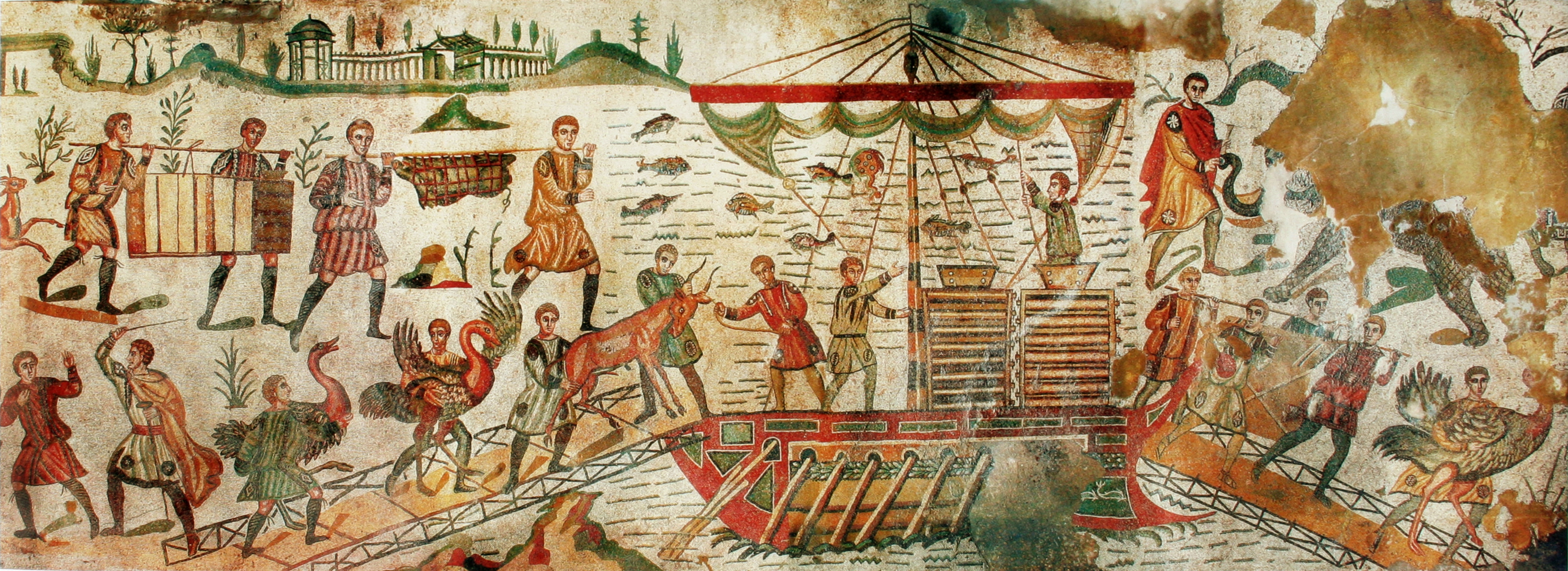
By Ahmed Fergiani
PREFACE
Around the 8th century BC the Phoenicians established several places along the coast of northern Africa. They were used to offer a save shelter for ships and as trading posts serving as a coastal outlet for products from the African hinterland. One of them, in Libya, was Sabratha. The Phoenicians gave it the Lybico-Berber name Sbrtn, roughly translated as ‘cereal market’, which, according to the 11th-century AD historian al-Bakari, suggests that on that spot there may have been a native town built prior to the Phoenicians' arrival. It became a Carthaginian colony around 500 BC, known as Tsabatan, and part of a tri-city trade network (Sabratha, Oea and Lepcis) known to the Greeks as the Emporia (The Romans should call it later on Tripolitana which became also the name of the province).
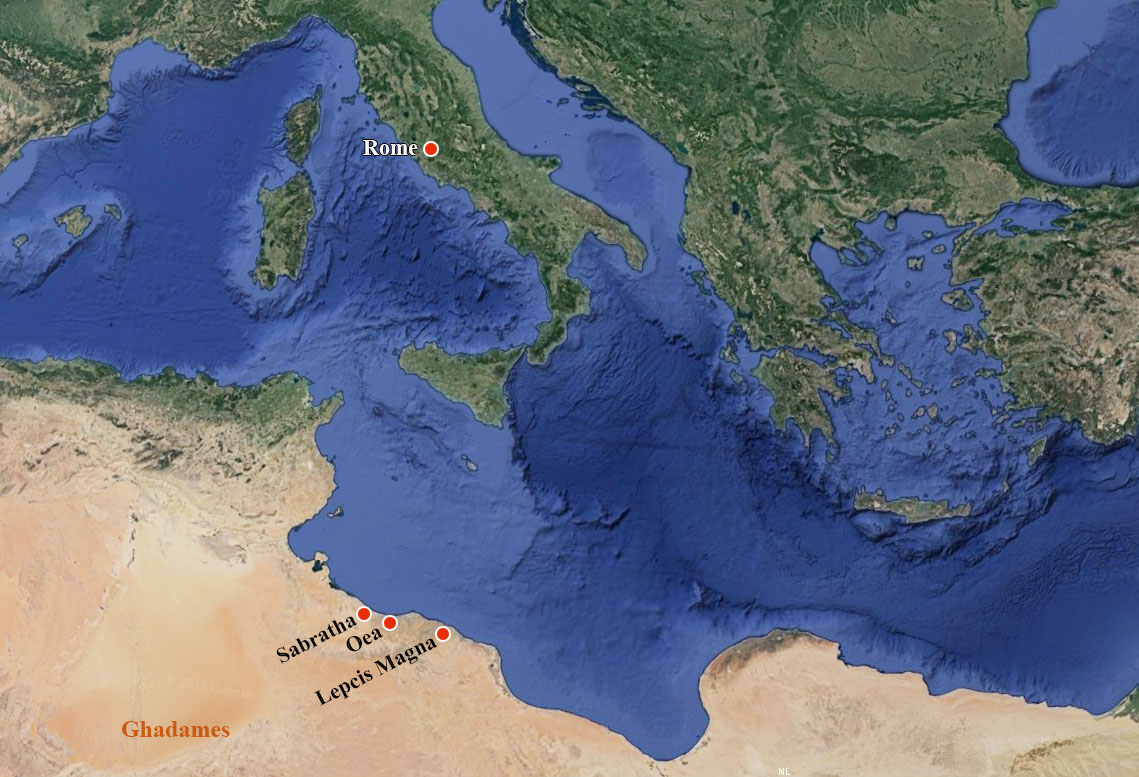
Carthaginian Sabratha was one of their most lucrative ports primarily thanks to the direct route between the city on the coast and the Oasis of the Ghadames in the interior. The city steadily developed as greater demand grew for the goods the Ghadames could deliver. The population too increased, a market was added, as well as temples.
There are still witnesses of the wealth of Sabratha under Carthage; the Mausoleum of Bes, after the theatre probably the most famous structure at the site.
The turning point for the city was the Second Punic War (218-202 BCE) which was lost by the Carthaginians and Carthage was destroyed.
Although Sabratha itself was not involved in the conflict, it changed hands afterwards when Masinissa of Numidia added the city to his kingdom. Rome let him do in North Africa whatever he wanted and Masinissa established his great Kingdom of Numidia. His successor provoked Rome to declare war on him in 112 B.C. After his defeat and execution in 105 B.C, Rome partitioned North Africa and took Sabratha and the other ports of trade. There is no doubt that it again became a prosperous city and must have had many impressive structures.
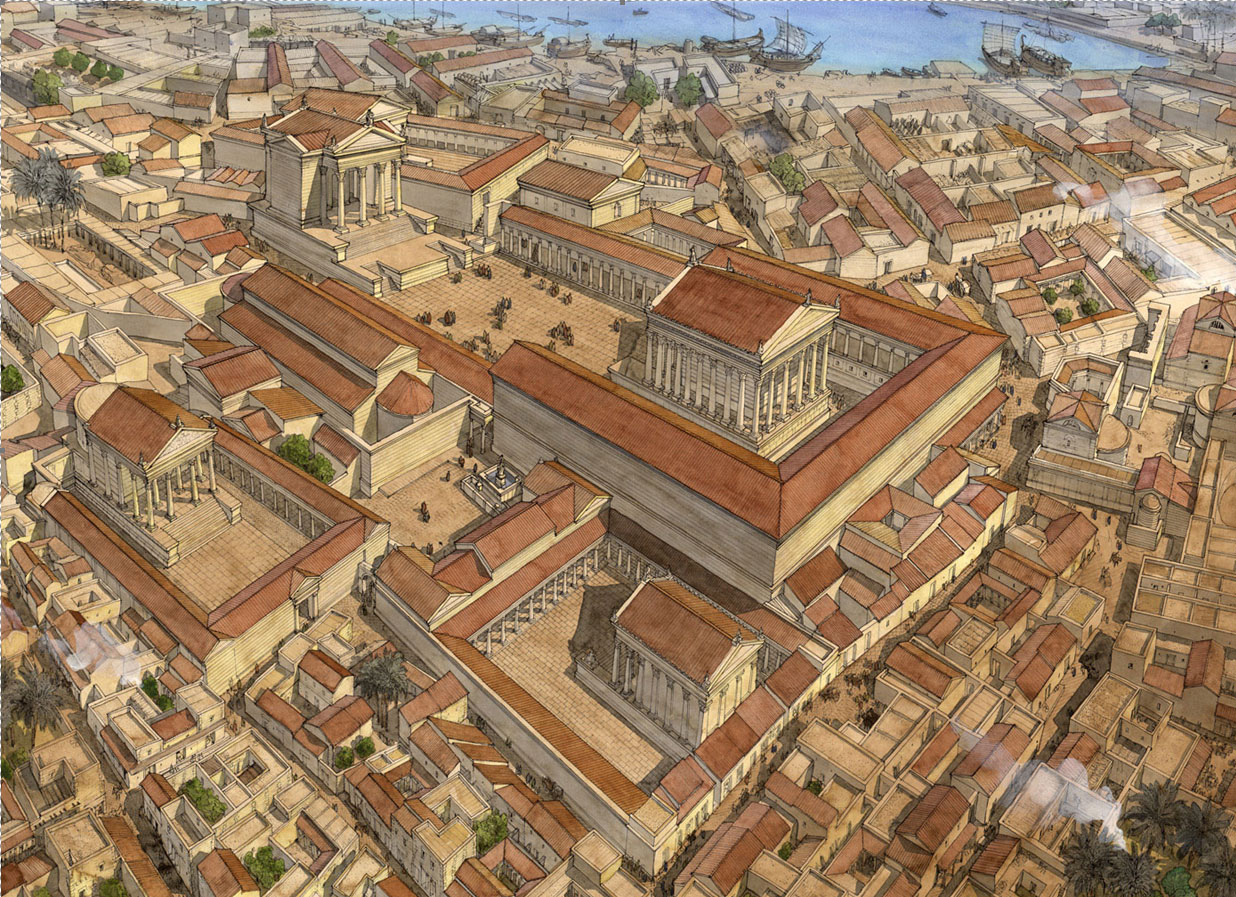
Over 50 years later Julius Caesar incorporated Sabratha into his province of Africa Nova and ordered renovations to improve the city’s infrastructure.
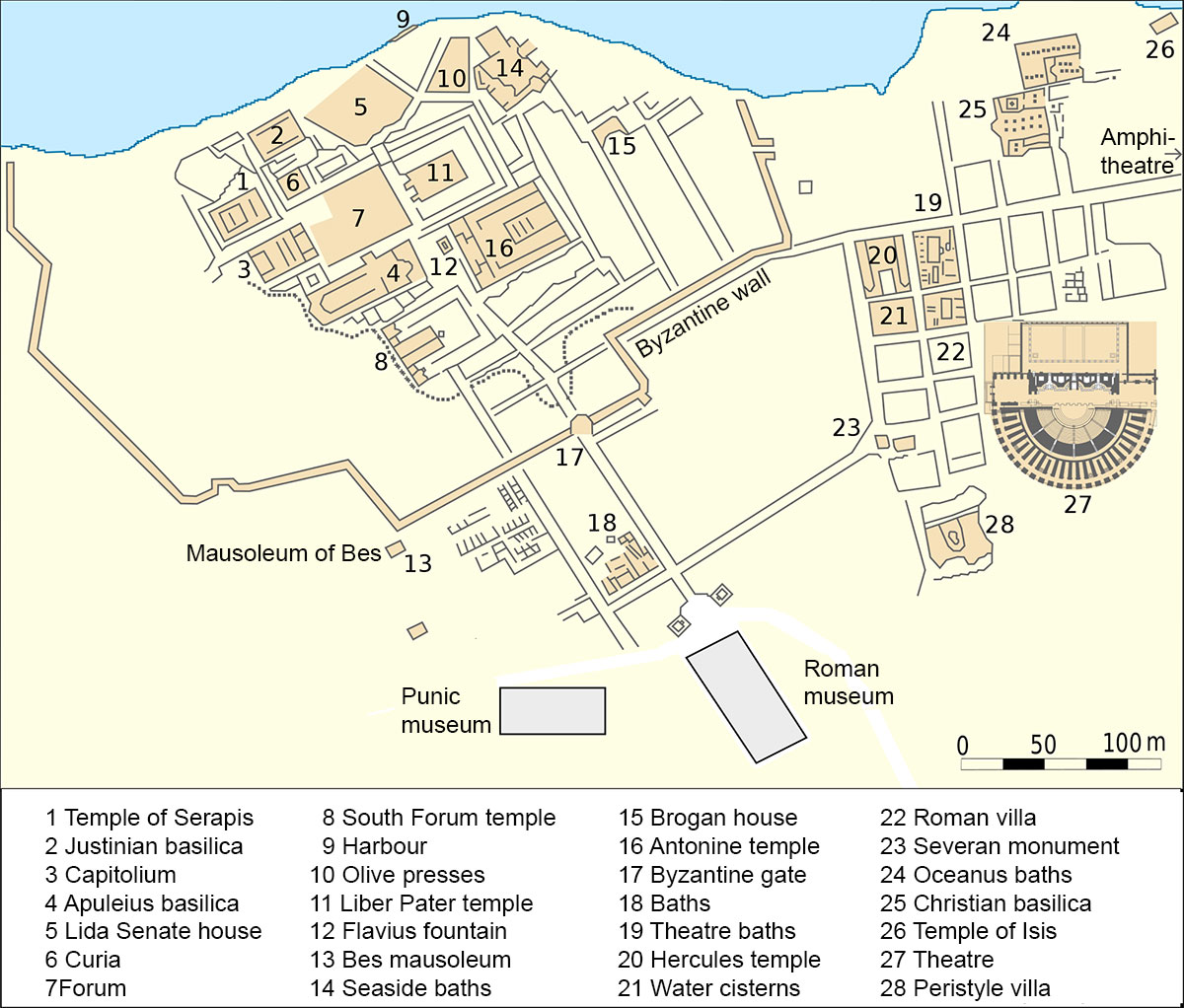
Near the old marketplace a forum and a basilica for settling legal matters were added to the city as well as the first Temple of Isis during the reign of Augustus (27 B.C. - 14 AD) and theses were later renovated under Antoninus Pius (138-161 AD). The Antonine Period, in fact, was Sabratha’s height of fame and prosperity as it was during this time that the city was completely renovated to become the jewel of the North African coast.
The ruins you can see today are mostly from that time. There was a new temple of Isis, a temple for Serapis and for the deity Liber Pater who presided over fertility, personal freedom, wine and viticulture. There were Roman baths, a theatre and amphitheater. Antoninus also made Sabratha to a colony with Roman rights under the law for the citizens. Once a colony, Sabratha established a trade office at the port of Ostia near Rome and increased their reach in trade.
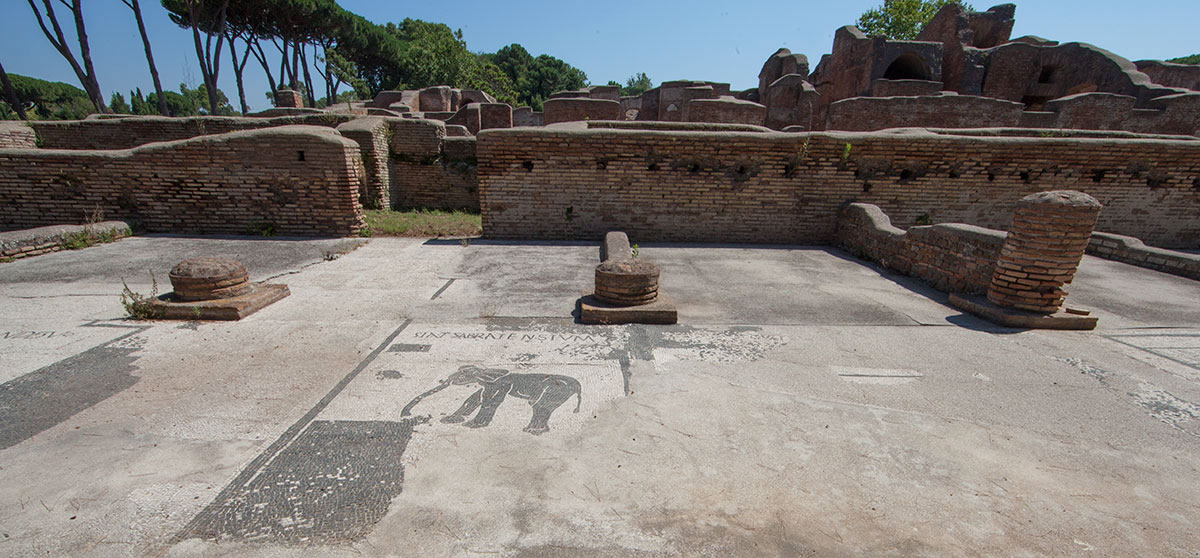
Panem et Circensis
In the mean time Rome was the Mecca Of the Mediterranean and beyond. It was the first city reaching one million inhabitants. One in four of them was either a slave or extremely poor. To avoid any eventual revolte the emperors offered the people panem et circenses2 (bread and circuses or bread and games).
Bread (wheat) was already given free to the poor people under the instigation of the Roman politician Gaius Sempronius Gracchus in 123 BC, entertainment was the second cornerstone. The Roman emperors organized lots of gladiator games for free in which also many exotic and wild animals from all over the world were involved. The emperor Augustus claims in his Res Gestae divi Augusti 3 (The Deeds of the Divine Augustus) that he had killed 3.500 African animals in 26 hunting occasions know as Venationes (venatio = hunting): 400 tigers, 260 lions, 600 panthers, and other animals of all sorts: seals, bears, eagles, etc.
The succeeding emperors did similar, sometimes even in bigger quantities. The costs were enormous, so high that in hard times some emperors had to cut back on expenses, by giving away the animals to private citizens as a present.

The Flavian emperors and the Colosseum
Flavia Domitilla the elder, the wife of Vespasian, the founder of the Flavian dynasty, was born in Sabratha to Italian colonists who had moved there during the reign of Augustus. Before becoming an emperor Vespasian served as governor of Africa. During this time, he found himself once in financial difficulties and was forced to mortgage his estates to his brother. To revive his fortunes he turned to the mule trade and gained the nickname mulio (muleteer)5.
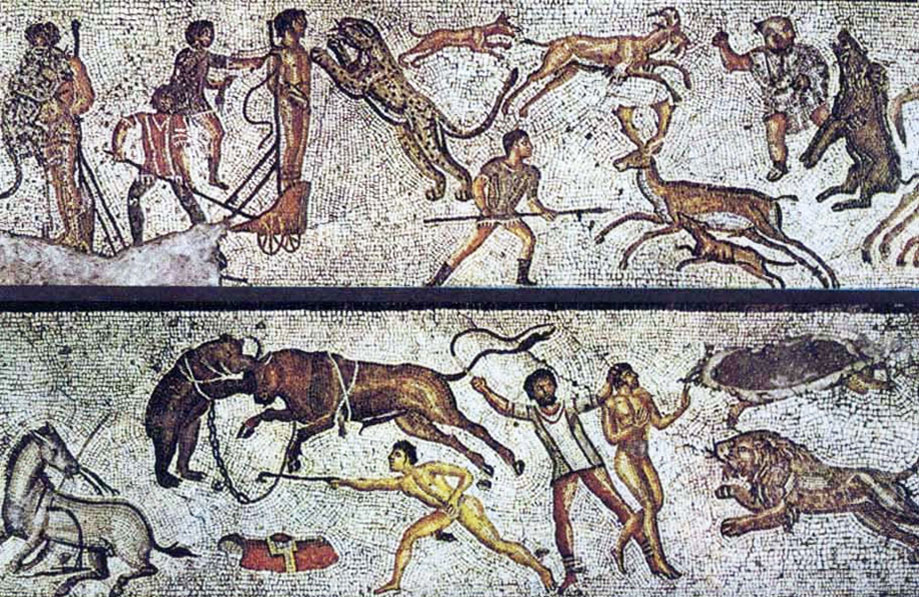
Vespasian with his Sabrathan ties, was no longer the muleteer once he sat on the throne of Rome, he knew par excellence what was needed in Rome, a large amphitheatre! So, he started building the Colosseum that would host no less than 50000 spectators. An imposing edifice where gladiators fought ferociously and loads of animals were needed to kill criminals in the appreciated games of Demnatio ad Bestias (condemnation to beasts) or to be killed in hunting games by trained hunters known as Venatores. When the Colosseum was inaugurated, 9.000 animals were killed, and Suetonius affirms that 5.000 wild beasts were presented to the audience in one single day. Even if these figures are exaggerated, nevertheless in North Africa lions and elephants disappeared, hunted for centuries in order to provide for the games. To satisfy the need of the Colosseum, the Sabrathans were ready, they were the masters of the trade routes with central Africa, through other Libyan populations called the Garamants, roughly the ancestors of the famous Tuaregs.
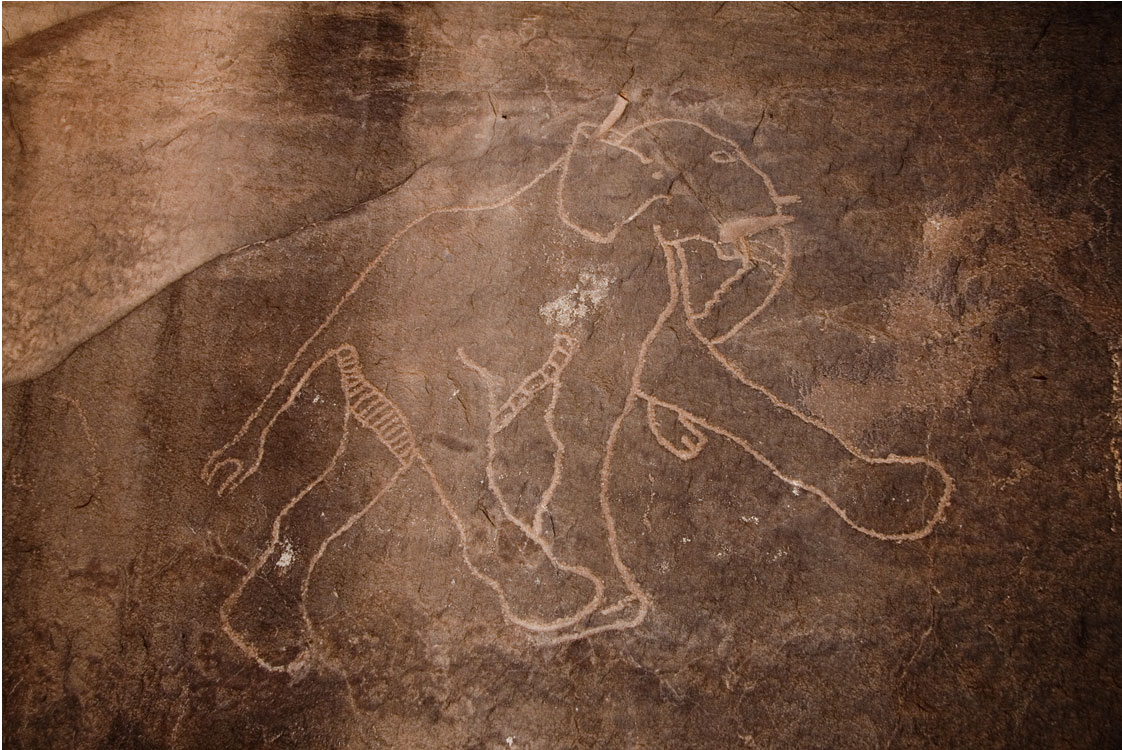
The Garamants and other indigenous populations left thousands of prehistoric rock paintings and carvings with hunting scenes in the Akakus area in southern Libya. These people were capable of supplying the Sabrathans with what Rome needed, living wild and exotic animals in good condition not only for the games but also for the private collections.
Once the Sabrathans had received the supplies, they were brought to the harbour of Sabratha where the fleet was waiting already. Before leaving the harbor, founded by the Phoenicians and enlarged by the Romans, and heading for Rome the sailors prayed and asked the protection of the Egyptian goddess known as Isis, the protector of the sailors, whose temple stands right on the shore of Sabratha (photo 4 no 26).
As the sailing was dangerous and reaching a destination uncertain, the sailors needed more divine protection. On the prows of their ships, full of wild animals, olive oil amphorae, grains, and much more of the highly appreciated exotic products, the images of another Egyptian divinity, the fearsome Bes, was placed to scare pirates and to defeat the evil eye before setting sail to harbours in Sicily or Ostia near Rome.
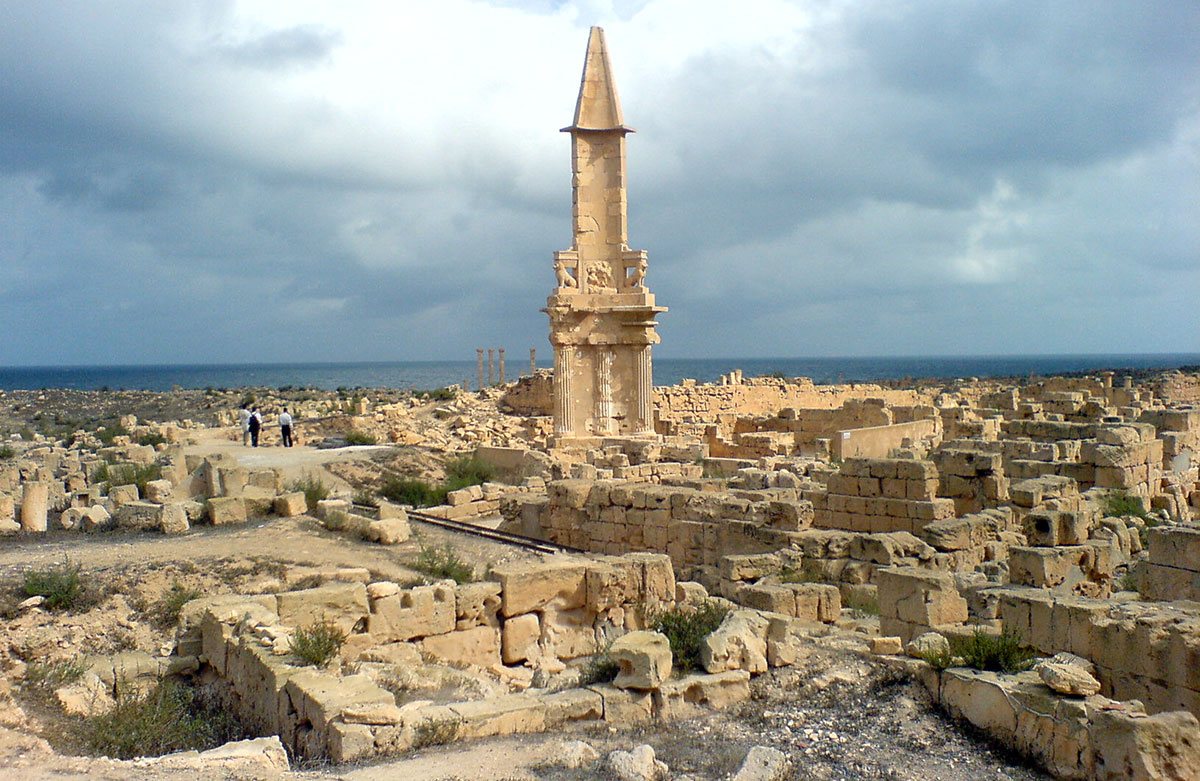
After arriving at Ostia, the already mentioned permanent trading post of Sabratha known as Statio Sabratensis (Office of Sabratha) behind the theater of Ostia was in charge of sending the merchandise via the river Tiber to the forum Boarium in Rome. Used empty Amphorae became part of the Monte Testatccio, while the wild animals were delivered to local brokers and resold to the colloseum making a fortune from introducing animals never seen before by most of the Rome inhabitants.
For nearly four centuries, this was a costume; animals from Africa provided by Sabratha to the Colosseum and the bloodthirsty inhabitants of Rome knew the name of Sabratha and its supplies.
Sabratha reached its zenith with Antoninius. Wealth was reigning in Sabratha, the Sabrathans were rich, happy and posh, but an event was the sign that their wealth was going to fade! The Sabrathans had to await their future, winds of change were about to change the faith of the city.
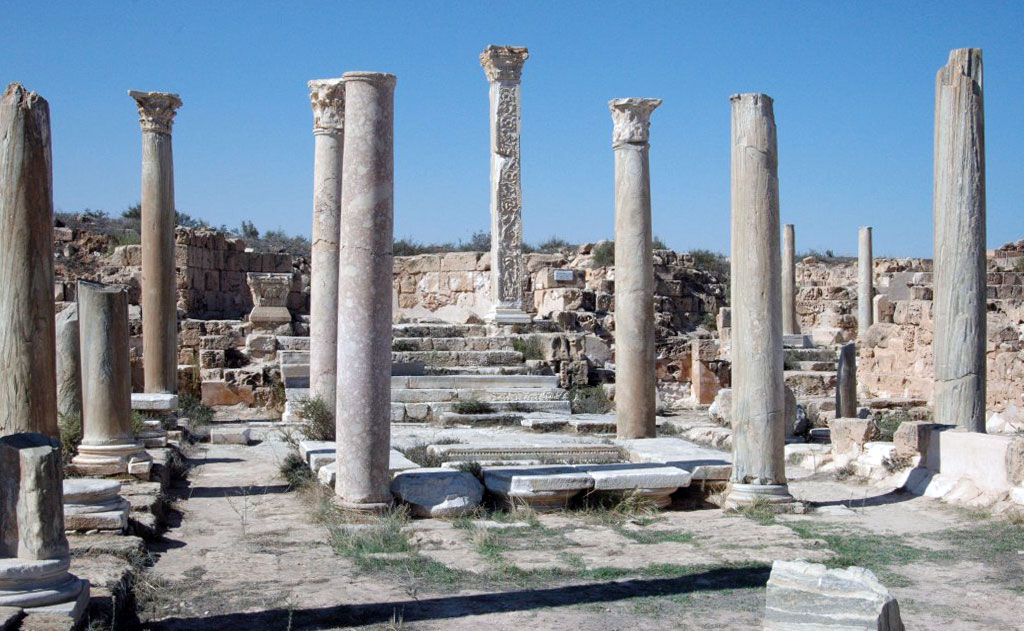
In 158 AD A famous trial took place in Sabratha when a certain Apuleius9 from Madaurax (a city in today’s Algeria), was accused by the wicked Sabrathans for having forced a rich widow from Oea into marrying him with magic. He was innocent and presented his Apologia (defence) in the basilica of Sabratha.
Apuleius wrote Metamorphoses or Asinus Aureus ( the golden ass =donkey), the only Latin novel that has survived in its entirety. It is an imaginative, irreverent, and amusing work that relates the ludicrous adventures of one Lucius, who experiments with magic and is accidentally turned into an ass.
About two centuries later, Sabratha was captured by the Vandals of Spain, the Byzantines of Asia minor and the Arabs from Arabia, while the Colosseum with the spread of Christianity was abandoned in 523, leaving distant memories about these today’s distant cities.
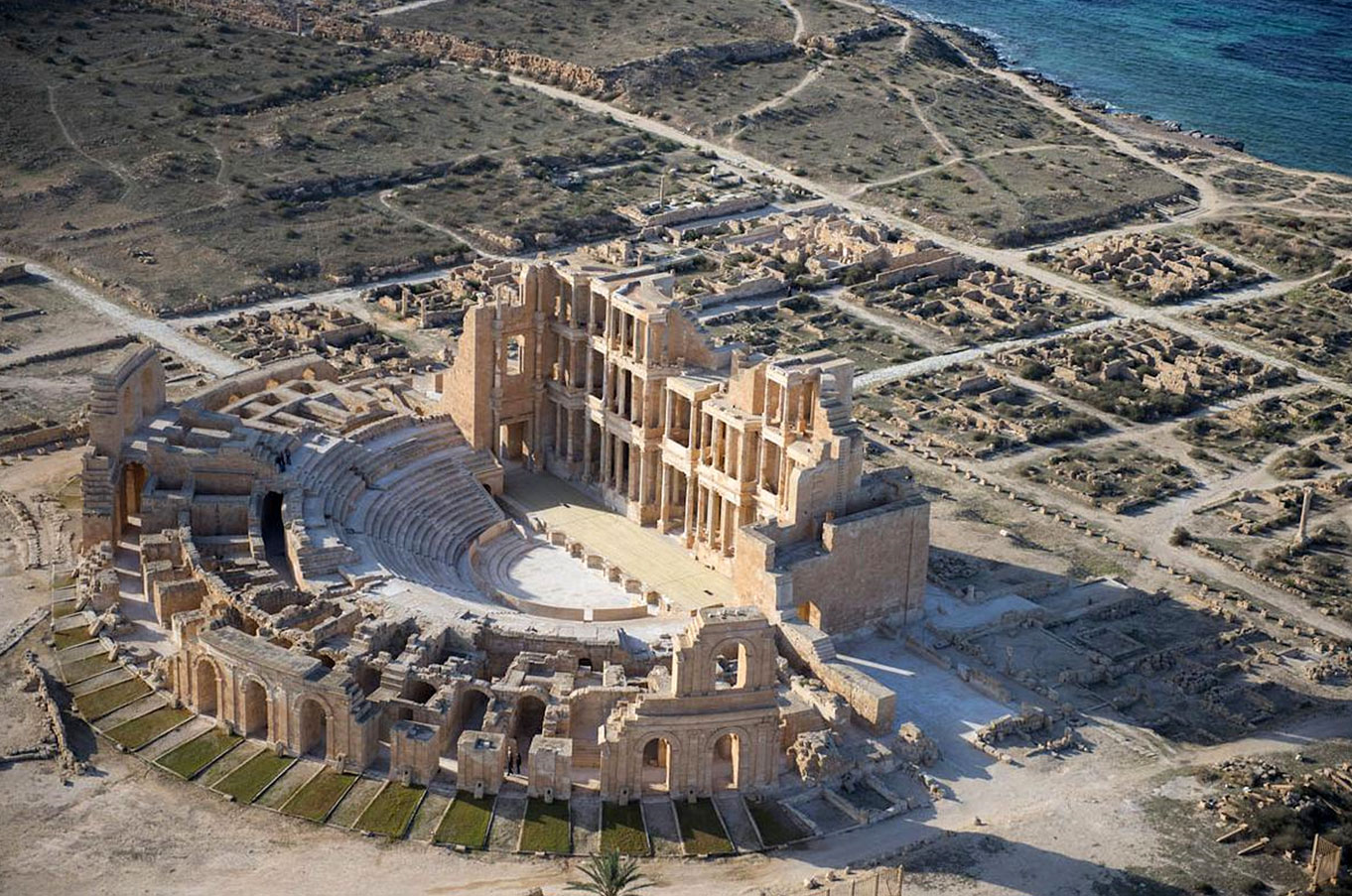
Today, Sabratha ruins testify different epochs, Phoenicians, Punics, Romans and lots of Byzantines mosaics and churches, but what attracts first is the only existing Punic monument in North Africa, the Mausoleum of Bes (see photo 9).
From Roman times we still find a lot of structures like: the Roman forum with a dozen of Pagan temples, thermal baths and an amphitheatre with 10.000 spectators of capacity. The above mentioned Roman ruins are dominated by the Roman theatre (photo 11), the 2nd biggest in North Africa and the most imposing monument in Sabratha.
The harbour
When Sabratha was excavated no serious work was done to discover the extent of the harbour. In 1966 the members of the Cambridge University Underwater Exploration Group found during their expedition to Sabratha a concrete capped natural breakwater, 300 meter breakwater of boulders and a quay system of blocks.
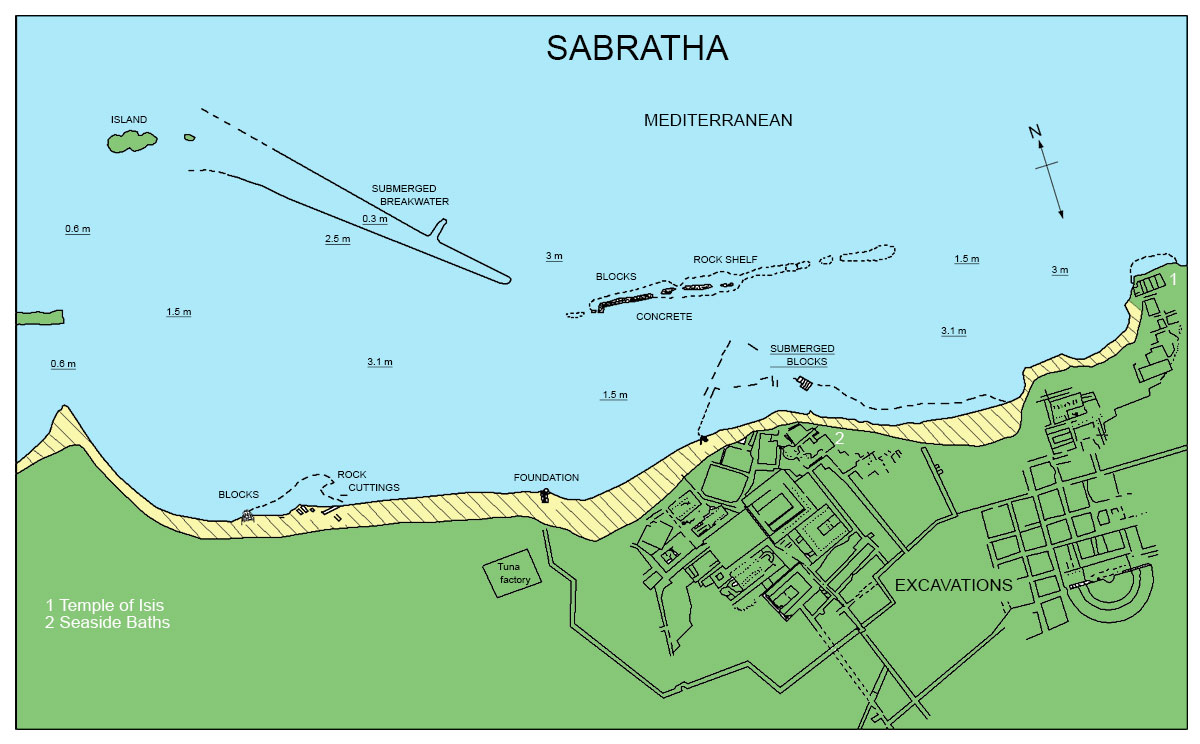
At the western end of the reef which rune parallel to the shore were probably buildings in ancient times.
North of the Seaside Baths a complex system of rectangular blocks was discovered running 75 meters out towards the reef. In the area of the blocks there were a number of sandstone and cipollino columns. It is suggested that the blocks were the remains of a quay with a porticoed building or warehouse built on it.
On the western shore of the bay a small quay, made from cut blocks and numerous parallel rock cuttings was found. Further east, north of the Tuna Factory, a circular structure lay at water’s edge. Maybe the foundation of a lighthouse.
The harbor lay probably only within the reef and, despite no traces have been found, a causeway should have connected the eastern end of the reef to the land in the vicinity of the temple of Isis. The discovery of the breakwater considerable enlarges the area that would have been suitable sheltered for mooring boats. The positions of the two quays suggests also that boats could have been loaded and unloaded at both ends of the harbor.
Today standing on the beach of Sabratha it is sad to see that a city that once flourished, thanks to the maritime trade, its port is hard to recognize, only in summer time, you can spot the breakwater barriers and portions of the quay, in other words, little rocks and islands. Fortunately though, the shipping area, adjacent to the port is in quite good conditions with its basins, olive oil storage facilities, milling stones, and fish processing pits for making the famous fish sauce, the Garum, shipped all over the Mediterranean.
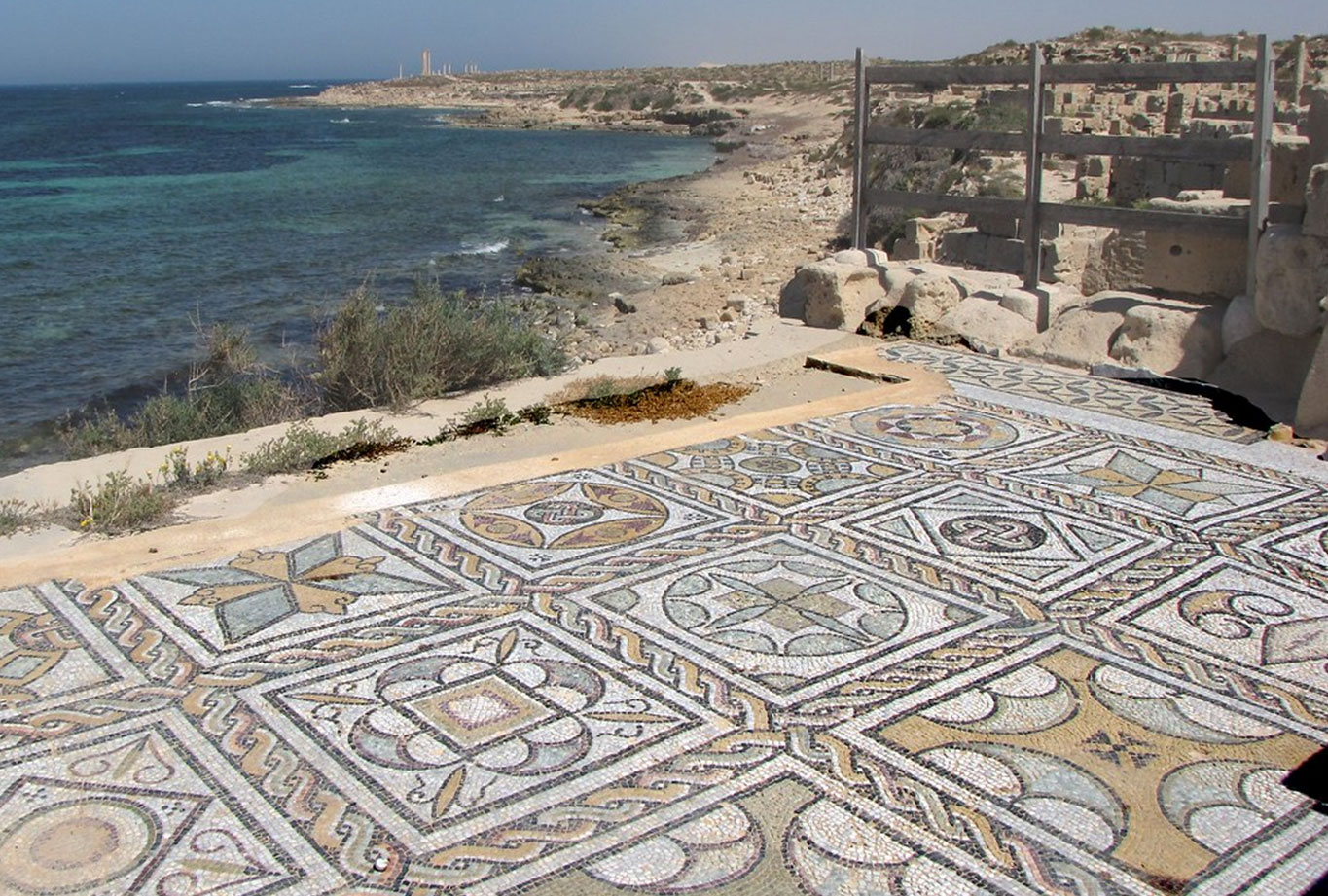
Sources- -Ancient History Encyclopedia-Sabratha
- -Cities in the Sand: Leptis Magna and Sabratha in Roman Africa by Kenneth D. Matthews, 1957 philadilphia.
- -Gladiators and Beast Hunts: Arena Sports of Ancient Rome - Christopher Epplett.
- -Suetonius, Divus Vespasianus
- -Antonino di Vita, La Libye antique, Cites perdues dans l’empire romain, 1998 Paris
- -Sabratha, a guide for visitors by Philip Ward, 1970.
- -Cambridge expedition to Sabratha 1966 (Lady Brogan, M.A. F.S.A. and Dr. K. Kenyon)
Notes- 1:copyright: from Le Musée absolu, Phaidon, 10-2012. Rare scene of two separate events on a single tableau, a common narrative technique in Roman visual arts
- 2:Panem et circenses- This phrase originates from Rome in Satire X of the Roman satirical poet Juvenal (c. AD 100). In context, the Latin panem et circenses (bread and circuses) identifies the only remaining interest of a Roman populace which no longer cares for its historical birthright of political involvement.
- 3:Res Gestae divi Augusti - the funerary inscription of the first Roman emperor, Augustus, giving a first-person record of his life and accomplishments
- 4:Photo: Wikipedia - Sebastian Straub
- 5:Suetonius, Vesp. 4–5
- 6:Jamahiriya Museum, Tripoli, Libya. From Dar Buc Ammera villa (Zliten). Photo:Wikipedia
- 7:Photo Mausoleum of Bes: Artur-Bergman.
- 8:TPhoto: Stilus.nl
- 9:Lucius Apuleius Madaurensis; c. 124 – c. 170 AD)






 We are committed to providing versions of our articles and interviews in several languages, but our first language is English.
We are committed to providing versions of our articles and interviews in several languages, but our first language is English.